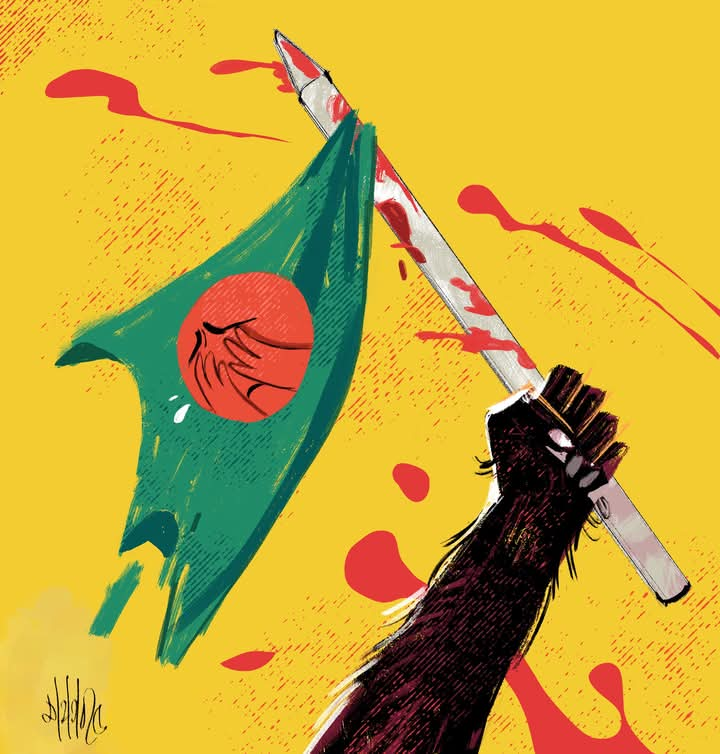In 1971, during the Bangladesh Liberation War, one of the most brutal chapters in modern history unfolded, particularly affecting the Hindu community and the Awami League in what was then East Pakistan. This conflict, which led to the creation of Bangladesh, was marked by widespread violence, including genocide, rape, arson and looting, forced conversion to Islam, and mass displacement to India.
The war stemmed from deep-seated political, linguistic, and cultural tensions between East and West Pakistan. The imposition of Urdu as the national language, economic neglect, and political disenfranchisement culminated in the demand for autonomy by Bengalis, leading to the Six Point Movement by Awami League President Sheikh Mujibur Rahman.
West Pakistani military ruler General Yahya Khan refused to hand over power to the Awami League after its landslide victory in the 1970 and launched the barbaric Operation Searchlight by the Pakistani military on March 25, 1971, aiming at crushing the independence movement. Hindus, perceived as supporters of the Mukti Bahini (guerrilla freedom fighters) and the Awami League, became prime targets in this operation.
Genocide and Mass Killings
- Operation Searchlight (March 25, 1971): This operation marked the beginning of systematic violence against Hindus. In the capital, Jagannath Hall at Dhaka University, known for housing Hindu students, and Hindu localities in Old Dhaka were raided, leading to numerous deaths.
- Chuknagar Massacre (May 20, 1971): Perhaps the most infamous, this massacre in Khulna resulted in the deaths of an estimated 10,000 to 12,000 unarmed civilians, predominantly Hindus, in a few hours. The Pakistani Army, with local collaborators, turned Chuknagar into a killing field where people were shot, bayoneted, or drowned in the river. These people gathered here from different nearby areas to cross the border to take refuge in India.
- Jathibhanga Massacre (April 23, 1971): In Thakurgaon, around 3,000 Hindus were killed in what was described as a deliberate extermination effort. The brutality included setting homes ablaze and shooting or hacking people as they tried to escape.
- Aditmari, Baushgari, and Dakshin Sagar Massacres: These incidents in April, May, and late March respectively, saw hundreds to thousands of Hindus killed, often with their homes and villages burned down.
- Demra and Barguna: In the suburbs of Dhaka and in Barguna, further mass killings occurred, with patterns of targeting Hindu-majority areas.
Rape as a Weapon of War
The war was also marked by widespread sexual violence, with Hindu women being deliberately targeted.
- Estimates suggest that between 200,000 to 400,000 women were raped, with some sources claiming higher numbers. The Pakistani Army established rape camps where women were brought by local collaborators like razakar and Peace Committee members and subjected to repeated assaults. Survivor accounts, like those in “Ami Birangana Bolchi,” recount the systematic nature of these violations, aimed at humiliating and demoralizing the Bengali community, with a particular focus on Hindus.
Arson and Destruction
Arson was used extensively to destroy Hindu property, religious sites, and cultural symbols alongside establishments belonging to the Awami League supporters. The Ramna Kali Mandir in Dhaka was demolished, symbolizing the cultural genocide alongside physical extermination.
Forced Conversion and Deportation
- Forced Conversion to Islam: Many Hindus were given the ultimatum to convert or face death. This was not only a survival strategy for some but also a method of cultural erasure enforced by the military and their local allies.
- Deportation to India: The violence led to an unprecedented refugee crisis, with millions of Hindus fleeing to India. Refugee camps in West Bengal, Tripura, Assam and other border states became home to these displaced people. The scale of this migration was so vast that it’s considered one of the largest refugee movements in history.
Survivor Testimonies and Long-term Impact
Survivor stories paint a vivid picture of the horror. They describe nights of terror, the loss of entire families, and the desperate journey to safety. These narratives not only document the atrocities but also the resilience of those who survived.
The aftermath of this genocide has had a lasting impact:
- Demographic Change: The Hindu population in Bangladesh has significantly decreased since 1971, both through direct violence and subsequent emigration due to continued persecution.
- Psychological Trauma: The survivors and their descendants live with the psychological scars of these events, affecting generations.
- Cultural Loss: The destruction of cultural sites and the forced assimilation have led to a loss of cultural identity among many Hindus in Bangladesh.
Historians say the Hindu genocide in 1971 was not just a byproduct of war but a calculated campaign of ethnic cleansing. While Bangladesh’s independence brought an end to these immediate atrocities, the legacy of 1971 lingers, with calls for acknowledgement, justice, and reconciliation still echoing through survivor communities. Although the international community’s recognition of these events as genocide remains a contentious issue, survivor testimonies and historical records provide ample evidence of the horrors endured by the Hindu community during that fateful year.


মন্তব্য করুন
মন্তব্য করার জন্য আপনাকে অবশ্যই লগইন করতে হবে।